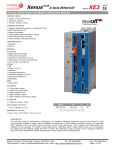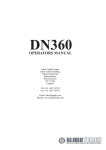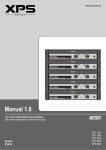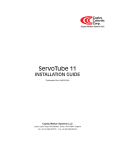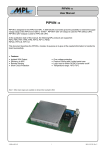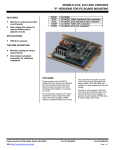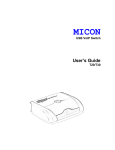Download Accelnet Micro Panel
Transcript
Copley Controls Corp. Accelnet Micro Panel ™ DIGITAL SERVOAMPLIFIER for BRUSHLESS or BRUSH MOTORS Control Modes • Indexer, Point-to-Point, PVT • Camming, Gearing, Position, Velocity, Torque Command Interface • CANopen/DeviceNet • ASCII and discrete I/O • Stepper commands • ±10V position/velocity/torque command • PWM velocity/torque command • Master encoder (Gearing/Camming) Communications • CANopen/DeviceNet • RS232 Feedback • Digital Quad A/B encoder • Secondary encoder / emulated encoder out • Digital Halls I/O - Digital • 9 inputs, 4 outputs Dimensions: mm [in] • 97 x 63 x 33 [3.8 x 2.5 x 1.3] description Accelnet Micro Panel is a compact, DC powered servo drive for position, velocity, and torque control of AC brushless and DC brush motors. It can operate on a distributed control network, as a stand-alone indexing drive, or with external motion controllers. Model Ip Ic Vdc ACJ-055-09 9 3 55 ACJ-055-18 18 6 55 ACJ-090-03 3 1 90 ACJ-090-09 9 3 90 ACJ-090-12 12 6 90 Indexing mode enables simplified operation with PLC’s which use outputs to select and launch indexes and inputs to read back amplifier status. Additionally, a PLC can send ASCII data that can change motion profiles so that one index can perform various motions as machine requirements change. DeviceNet capability enables multiple Accelnet drives to be controlled from PLC’s that use this communication protocol. The CANopen distributed control architecture is also supported. As a CAN node operating under the CANopen protocol, it supports Profile Position, Profile Velocity, Profile Torque, Interpolated Position, and Homing. Up to 127 drives can operate on a single CAN bus and groups of drives can be linked via the CAN so that they execute motion profiles together. Operation with external motion controllers is possible in torque (current), velocity, and position modes. Input command signals can be ±10V (torque, velocity, position), PWM/Polarity (torque, velocity), or stepper format (CU/CD or Step/Direction). Copley Controls Corp., 20 Dan Road, Canton, MA 02021, USA Web: www.copleycontrols.com Tel: 781-828-8090 Fax: 781-828-6547 Page of 14 Copley Controls Corp. Accelnet Micro Panel ™ DIGITAL SERVOAMPLIFIER for BRUSHLESS or BRUSH MOTORS GENERAL SPECIFICATIONS Test conditions: Load = Wye connected load: 2 mH + 2 Ω line-line. Ambient temperature = 25°C, +HV = HVmax MODEL ACJ-055-09 ACJ-055-18 ACJ-090-03 ACJ-090-09 ACJ-90-12 Output Power Peak Current 9 (6.36) 18 (12.73) 3 (2.12) Peak time 1 1 1 Continuous current 3 (2.12) 6 (4.24) 1 (0.71) Peak Output Power 490 970 270 Continuous “ “ 163 323 89 Output resistance 0.075 0.075 0.075 Maximum Output VoltageVout = HV*0.97 - Rout*Iout 9 (6.36) 1 3 (2.12) 800 267 0.036 12 (8.5) 1 6 (4.24) 1600 533 0.075 Adc (Arms, sinusoidal), ±5% Sec Adc (Arms, sinusoidal), ±5% W W Rout (Ω) INPUT POWER HVmin to HVmax +20 to +55 +20 to +55 +20 to +90 +20 to +90 +20 to +90 Ipeak 9 18 3 9 12 Icont 3 6 1 3 6 Aux HV+20 to +HVmax @ 500 mAdc maximum PWM OUTPUTS Type PWM ripple frequency Vdc, Transformer-isolated Adc (1 sec) peak Adc continuous 3-phase MOSFET inverter, 15 kHz center-weighted PWM, space-vector modulation 30 kHz DIGITAL Control Digital Control Loops Sampling rate (time) Commutation Modulation Bandwidths HV Compensation Minimum load inductance Current, velocity, position. 100% digital loop control Dual loop position control using secondary encoder input Current loop: 15 kHz (66.7 us) Velocity, position loops: 3 kHz (333 us) Sinusoidal field-oriented control or trapezoidal from Halls for brushless motors Center-weighted PWM with space-vector modulation Current loop: 2.5 kHz typical, bandwidth will vary with tuning & load inductance Changes in bus voltage do not affect bandwidth 200 µH line-line command inputs CANopen Digital position Digital torque & velocity Analog torque/velocity/position Profile Position, Interpolated Position, Profile Velocity, Profile Torque, Homing Step/Direction, CW/CCW Stepper commands (2 MHz maximum rate) Quad A/B Encoder 20 Mcount/sec (after quadrature), 5 Mline/sec PWM , Polarity PWM = 0~100%, Polarity = 1/0 PWM PWM = 50% ±50%, no polarity signal required PWM frequency range 1 kHz minimum, 100 kHz maximum PWM minimum pulse width 220 ns ±10 Vdc, 5 kΩ differential input impedance digital inputs Number, type All inputs Logic levels Pull-up, pull-down control Enable [IN1] GP [IN2,3,4] MS [IN5] HS [IN6,7,8,9] 9, non-isolated. [IN1] dedicated to Amp Enable function, [IN2]~[IN9] are programmable 74HC14 Schmitt trigger operating from +5 Vdc with RC filter on input 10 kΩ to +5 Vdc or ground for all except [IN5] (see below) Vin-LO < 1.35 Vdc, Vin-HI >3.65 Vdc, Input voltage range 0 to +24 Vdc All inputs have group selectable connection of input pull-up/down resistor to +5 Vdc, or ground 1 Dedicated input with 330 µs RC filter for amplifier enable 3 General Purpose inputs with 330 µs RC filter 1 Medium-Speed input for motor temperature switch, 33 µs RC filter, 4.99 kΩ pullup/pulldown 4 High-Speed Inputs inputs with 100 ns RC filter digital outputs (NOTE 1) Number, type [OUT1~4] Current rating 4, non-isolated, programmable Current-sinking MOSFET with 1 kΩ pullup to +5 Vdc through diode 100 mAdc max, +30 Vdc max. Functions programmable External flyback diode required if driving inductive loads Copley Controls Corp., 20 Dan Road, Canton, MA 02021, USA Web: www.copleycontrols.com Tel: 781-828-8090 Fax: 781-828-6547 Page of 14 Copley Controls Corp. Accelnet Micro Panel ™ DIGITAL SERVOAMPLIFIER for BRUSHLESS or BRUSH MOTORS MULTI-Mode encoder port Operation Signals Receiver Driver Frequency Motor encoder signals are buffered and appear on J5 for feedback to control system Programmable to be quadrature encoder input for electronic gearing A, /A, B, /B, X, /X 26C32 differential line receiver (for operation as an encoder input port) 26C31 differential line driver (for operation as buffered encoder outputs) 20 MHz (post-quadrature) RS-232 PORT Signals Mode Protocol RxD, TxD, Gnd Full-duplex, serial communication port for amplifier setup and control, 9,600 to 115,200 baud Binary or ASCII formats CAN PORTS Signals Isolation Format Data Address selection CANH, CANL, Gnd CAN interface circuit and +5 Vdc supply for CAN is optically isolated from amplifier circuits CAN V2.0b physical layer for high-speed connections compliant CANopen Device Profile DSP-402 Programmable to flash memory or determined by digital inputs motor connections Phase U, V, W Hall U, V, W Encoder A, /A, B, /B, (X,/X) Hall & encoder power Motemp [IN 5] Brake PWM outputs to 3-ph. ungrounded Wye or delta wound brushless motors, or DC brush motors Digital Hall signals, single-ended Digital quadrature encoder signals, differential (X or Index signal not required) 5 MHz maximum line frequency (20 Mcounts/sec) 26C32 differential line receiver with 121 Ω terminating resistor between complementary inputs +5 Vdc ±2% @ 250 mAdc max Motor overtemperature sensor switch input Programmable to disable amplifier when motor over-temperature condition occurs [OUT1~4] are programmable for motor brake function, external flyback diode required status indicators Amp Status CAN Status Bicolor LED, amplifier status indicated by color, and blinking or non-blinking condition Bicolor LED, status of CAN bus indicated by color and blink codes to CAN Indicator Specification 303-3 protections HV Overvoltage HV Undervoltage Amplifier over temperature Short circuits I2T Current limiting Motor over temperature Functions +HV > HVmax, Amplifier outputs turn off until +HV < HVmax (See Input Power for HV) +HV < +14 Vdc, Amplifier outputs turn off until +HV > +14 Vdc Heat plate > 70°C Output to output, output to ground, internal PWM bridge faults Programmable: continuous current, peak current, peak time Digital inputs programmable to detect motor temperature switch Fault conditions are programmable as latching or non-latching types MECHANICAL & ENVIRONMENTAL Size Weight Ambient temperature Humidity Contaminants Environment Cooling 3.83 x 2.47 x 1.29 in. (97.28 x 62.74 x 32.77 mm) 4.8 oz, 0.14 kg 0 to +45 °C operating, -40 to +85 °C storage 0 to 95%, non-condensing Pollution degree 2 IEC68-2: 1990 Conduction through heatplate on amplifier chassis, or convection Copley Controls Corp., 20 Dan Road, Canton, MA 02021, USA Web: www.copleycontrols.com Tel: 781-828-8090 Fax: 781-828-6547 Page of 14 Copley Controls Corp. Accelnet Micro Panel ™ DIGITAL SERVOAMPLIFIER for BRUSHLESS or BRUSH MOTORS CME 2™ SOFTWARE CANopen Networking Amplifier setup is fast and easy using CME 2™ software which communicates with the amplifier over CAN or an RS-232 link. All of the operations needed to configure the amplifier are accessible through this powerful and intuitive program. Auto-phasing of brushless motor Hall sensors and phase wires eliminates “wire and try”. Connections are made once and CME 2™ does the rest thereafter. Encoder wire swapping to establish the direction of positive motion is eliminated. Based on the CAN V2.0b physical layer, a robust, two-wire communication bus originally designed for automotive use where lowcost and noise-immunity are essential, CANopen adds support for motion-control devices and command synchronization. The result is a highly effective combination of data-rate and low cost for multi-axis motion control systems. Device synchronization enables multiple axes to coordinate moves as if they were driven from a single control card. Motor data can be saved as .ccm files. Amplifier data is saved as .ccx files that contain all amplifier settings plus motor data. This eases system management as files can be cross-referenced to ampifiers. Once an amplifier configuration has been completed systems can be replicated easily with the same setup and performance. RS-232 communications CAN status LED The CAN status LED operates in accordance with CAN specification 303-3. This is a bi-color LED that uses red and green colors in solid, flashing, and blinking states to indicate conditions on the CAN bus. The serial-port is three-wire (RxD,TxD, Gnd), full-duplex RS-232 that operates from 9600 to 115,200 Baud. Connections to the RS-232 port are through J5, the Signal connector. The Accelnet Micro Panel Serial Cable Kit (ACJ-SK) contains a 9-pin female SubD serial port (COM1, COM2, etc.) connector and 2m (6 ft.) cable that is terminated in a J5 cable connector. This provides an easy connection to the amplifier for set-up without wiring to J5. AMP status LED A bi-color LED gives the status of the amplifier by changing color, and either blinking or remaining solid. The possible color and blink combinations are: •Green/Solid: Amplifier OK and enabled. Will run in response to reference inputs or CANopen commands. •Green/Slow-Blinking: Amplifier OK but NOT-enabled. Will run when enabled. Status LEDS •Green/Fast-Blinking: Positive or Negative limit switch active. Amplifier will only move in direction not inhibited by limit switch. •Red/Solid: Transient fault condition. Amplifier will resume operation when fault is removed. •Red/Blinking: Latching fault. Operation will not resume until amp is Reset Fault conditions: • Over or under-voltage 34!453 ,%$ #!. ,%$ • Motor over-temperature • Phasing error (current position is > 60° electrical from Hall angle) • Short-circuits from output to output • Short-circuits from output to ground • Internal short circuits • Amplifier over-temperature • Position-mode following error Faults are programmable to be either transient or latching Copley Controls Corp., 20 Dan Road, Canton, MA 02021, USA Web: www.copleycontrols.com Tel: 781-828-8090 Fax: 781-828-6547 Page of 14 Copley Controls Corp. Accelnet Micro Panel COMMAND Inputs in Stand-Alone Mode ™ Current or Velocity Mode Reference Inputs The command inputs control the amplifier to produce an output and are used when the amplifier is taking current, velocity, or position commands from an external controller in standalone mode. The command inputs take digital and analog signals in a variety of formats: PWM/Direction Inputs Duty = 0~100% [IN7] [IN8] Current or Velocity Mode ±10V Analog DIGITAL SERVOAMPLIFIER for BRUSHLESS or BRUSH MOTORS Step Motor Emulation Inputs Pulse/Direction Inputs Pulse Current or Velocity [IN7] [IN8] Direction Polarity or Direction Position magnitude Position Increment or Decrement PWM/Direction PWM 50% Count-up/Count-down Inputs PWM 50% Input Position Mode CU/CD Duty = 50% ±50% [IN7] Step/Direction ±10V Analog Master Encoder <no connection> [IN8] Current or Velocity CW (or CU) [IN7] CCW (or CD) [IN8] No function Position Increase Position Decrease A/B Quadrature For current or velocity control, the PWM/Direction format takes a PWM signal at constant frequency which changes its’ duty cycle from 0 to 100% to control current or velocity and a DC level at the Direction input to control polarity. The PWM 50% format takes a single PWM signal that produces 0 output at 50% duty cycle, and maximum positive/negative outputs at 0% or 100%. As a protection against wiring faults, the 0% and 100% inputs can be programmed to produce 0 output. When this is done the max/min duty cycle range is >0% and <100%. Quad AB Encoder ±10 V Analog Input Ref(+) 37.4k 5.36k Ref(-) 37.4k Pos++ 5k Pos-- Ch. A Ch. B + A 5k + 1.5V - ENC B [IN8] [IN7] Master Enc. Ch. A Master Enc. Ch. B Position-control inputs take signals in popular stepper-motor format or from a digital quadrature encoder. The CU/CD format moves the motor in a positive direction for each pulse received at the count-up input. Negative motion is produced by pulses on the count-down input. The step-direction mode moves the motor an increment of position for every pulse received at the pulse input while the direction of movement is controlled by a DC level on the direction input. Master encoder quadrature signals (A,B) are decoded into four counts per encoder line with the direction derived from the logic-state transitions of the inputs. In position mode the ratio of motor motion per input-count is programmable. A ±10V analog command can control current, velocity, or position as well. multi-MODE ENCODER PORT This port consists of three differential input/output channels with functions programmable. Functional diagram of one channel For dual-loop position-mode operation that employs a primary encoder on the motor, and a secondary encoder on the load, the port works as an input receiving the secondary encoder’s quad A/B/X signals. For stand-alone operation with an external motion controller, the signals from the digital encoder on the motor are buffered and made available at the control signal connector for transmission to the controller. This eliminates split-wired motor cables with dual connectors that take the encoder signals to both amplifier and controller. Copley Controls Corp., 20 Dan Road, Canton, MA 02021, USA Web: www.copleycontrols.com Tel: 781-828-8090 Fax: 781-828-6547 Page of 14 Copley Controls Corp. Accelnet Micro Panel ™ DIGITAL SERVOAMPLIFIER for BRUSHLESS or BRUSH MOTORS digital INPUTS has nine digital inputs, eight of which have programmable functions. Input [IN1] is not programmable and is dedicated to the amplifier Enable function. This is done to prevent accidental programming of the input in such a way that the controller could not shut it down. Two types of RC filters are used: GP (general purpose) and HS (high speed). Input functions such as Step/Direction, CU/CD, Quad A/B are wired to inputs having the HS filters, and inputs with the GP filters are used for general purpose logic functions, limit switches, and the motor temperature sensor. Programmable functions of the digital inputs include : • • • • • • Positive Limit switch • Step & Direction, or CU/CD Negative Limit switch step motor position commands Home switch • Quad A/B master encoder Amplifier Reset position commands PWM current or velocity commands • Motor over-temperature CAN address bits In addition to the active level and function for each programmable input, the input resistors are programmable in three groups to either pull up to +5 Vdc, or down to ground. Grounded inputs with HI active levels interface to PLC’s that have PNP outputs that source current from +24 Vdc sources. Inputs pulled up to +5 Vdc work with open-collector, or NPN drivers that sink current to ground. GP Inputs 4,5 GP Inputs 1,2,3 24 Vdc max [IN1] [IN2] [IN3] +5V 10k 24 Vdc max Programmable 1/0 +5V 10k * 4.99k 74HC14 Programmable 1/0 74HC14 [IN4] *[IN5] 10k 10k * [IN5] connects to J4 for motor temperature sensor 33nF 33nF *3.3nF HS Inputs 6,7,8,9 5 Vdc max +5V [IN6] 10k Programmable 1/0 74HC14 [IN7] [IN8] [IN9] 1.0 k 100 pF +5V DIGITAL OUTPUTS Digital outputs are open-drain MOSFETs with 1 kΩ pull-up resistors to +5 Vdc. These can sink up to 100 mAdc from external loads operating from power supplies to +30 Vdc. When driving inductive loads such as a motor brake, an external fly-back diode is required. The diode in the output is for driving PLC inputs that are opto-isolated and connected to +24 Vdc. The diode prevents conduction from +24 Vdc through the 1 kΩ resistor to +5 Vdc in the amplifier. This could turn the input on, giving a false indication of the amplifier output state. These outputs are programmable to be on or off when active. Typical functions are amplifier fault indication or motor brake operation. Other functions are programmable. Copley Controls Corp., 20 Dan Road, Canton, MA 02021, USA Web: www.copleycontrols.com Tel: 781-828-8090 1k [OUT1] [OUT2] [OUT3] [OUT4] Fax: 781-828-6547 Page of 14 Copley Controls Corp. Accelnet Micro Panel ™ DIGITAL SERVOAMPLIFIER for BRUSHLESS or BRUSH MOTORS MOTOR CONNECTIONS Motor connections are of four types: phase, Halls, encoder and thermal sensor. The phase connections carry the amplifier output currents that drive the motor to produce motion. The Hall signals are three digital signals that give absolute position feedback within an electrical commutation cycle. The encoder signals give incremental position feedback and are used for velocity and position modes, as well as sinusoidal commutation. A thermal sensor that indicates motor overtemperature is used to shut down the amplifier to protect the motor. +5V Motor Temperature Sensor Digital input [IN5] is for use with a motor overtemperature switch. The input should be programmed as a pull-up to +5 Vdc if the motor switch is grounded when cold, and open or high-impedance when over-heating. 4.99 k 74HC14 10 k [IN5] 3.3 nF MOTOR ENCODER The input circuit for the motor encoder signals is a differential line-receiver with R-C filtering on the inputs. A 121 Ω resistor is across each input pair to terminate the signal pairs in the cable characteristic impedance. The circuit is shown below. Encoders with differential outputs are required because they are less susceptible to noise that can be picked on singleended outputs. For best results, encoder cabling should use twisted pair cable with one pair for each of the encoder outputs: A-/A, B-/B, and X-/X. Shielded twisted-pair is even better for noise rejection. 22 pF +5V 2k 1k A, B, X ENC /A, /B, /X 121 1k MOTOR HALL SIGNALS U W HALL 26LS32 22 pF +5V V Hall signals are single-ended signals that provide absolute feedback within one electrical cycle of the motor. There are three of them (U, V, & W) and they may be sourced by magnetic sensors in the motor, or by encoders that have Hall tracks as part of the encoder disc. They typically operate at much lower frequencies than the motor encoder signals, and are used for commutation-initialization after startup, and for checking the motor phasing after the amplifer has switched to sinusoidal commutation. + 10 k 10 k U, V, W 74HC14 3.3 nF +5 Vdc Motor Brake Digital outputs [OUT1,2,3,4] can be programmed to power a motor-mounted brake. These brake the motor when they are in an unpowered state and must have power applied to release. This provides a fail-safe function that prevents motor motion if the system is in an unpowered (uncontrolled) state. Because brakes are inductive loads, an external flyback diode must be used to control the coil voltage when power is removed. The timing of the brake is programmable. [OUT1] [OUT2] [OUT3], or [OUT4] motor phase connections +HV Input The amplifier output is a three-phase PWM inverter that converts the DC buss voltage (+HV) into three sinusoidal voltage waveforms that drive the motor phase-coils. Cable should be sized for the continuous current rating of the amplifier. Motor cabling should use twisted, shielded conductors for CE compliance, and to minimize PWM noise coupling into other circuits. The motor cable shield should connect to motor frame and the amplifier frame ground terminal (J2-1) for best results. PWM Outputs = Shielded cables required for CE compliance Copley Controls Corp., 20 Dan Road, Canton, MA 02021, USA Web: www.copleycontrols.com BRAKE 1k + 24 Vdc - Gnd Tel: 781-828-8090 Mot U U Mot V V Mot W W MOTOR Shld Fax: 781-828-6547 Page of 14 Copley Controls Corp. Accelnet Micro Panel ™ DIGITAL SERVOAMPLIFIER for BRUSHLESS or BRUSH MOTORS GROUNDING CONSIDERATIONS POWER Supplies Power and control circuits share a common circuit-ground (HV Gnd on J3-4, and Signal Ground on J2-5, J4-6 & 11, J5-2,9,15,17, and 28). Input logic circuits are referenced to Signal Ground, as are analog Reference inputs, digital outputs, encoder and Hall signals. For this reason, amplifier Gnd terminals should connect to the users’ ground system so that signals between amplifier and controller are at the same common potential, and to minimize noise. The system ground should, in turn, connect to an earthing conductor at some point so that the whole system is referenced to “earth”. The CAN ports are optically isolated from the amplifier circuits. Because current flow through conductors produces voltage-drops across them, it is best to connect the amplifier HV Return to system earth, or circuit-common through the shortest path, and to leave the powersupply floating. In this way, the power supply (-) terminal connects to ground at the amplifier HV Return terminals, but the voltage drops across the cables will not appear at the amplifier ground, but at the power supply negative terminal where they will have less effect. Motor phase currents are balanced, but currents can flow between the PWM outputs, and the motor cable shield. To minimize the effects of these currents on nearby circuits, the cable shield should connect to Gnd (J2-5). The amplifier heatplate does not connect to any amplifier circuits. Cables must be shielded for CE compliance, and the shields should connect to the Frame Ground terminals. When installed, the amplifier heatplate should connect to the system chassis. This maximizes the shielding effect, and provides a path to ground for noise currents that may occur in the cable shields. Signals from controller to amplifier are referenced to +5 Vdc, and other power supplies in user equipment. These power supplies should also connect to system ground and earth at some point so that they are at same potential as the amplifier circuits. The final configuration should embody three current-carrying loops. First, the power supply currents flowing into and out of the amplifier at the +HV and Gnd pins on J3. Second the amplifier outputs driving currents into and out of the motor phases, and motor shield currents circulating between the U, V, and W outputs and Gnd. And, lastly, logic and signal currents connected to the amplifier control inputs and outputs. For CE compliance and operator safety, the amplifier should be earthed by using external tooth lockwashers under the mounting screws. These will make contact with the aluminum heatplate to connect it to the equipment frame ground. Amplifier Controller Mot U Control I/O Mot V MOTOR Mot W +HV Signal Gnd + Gnd - Power Supply Accelnet Micro Panel operates typically from transformer-isolated, unregulated DC power supplies. These should be sized such that the maximum output voltage under highline and no-load conditions does not exceed the amplifiers maximum voltage rating. Power supply rating depends on the power delivered to the load by the amplifier. In many cases, the continuous power output of the amplifier is considerably higher than the actual power required by an incremental motion application. Operation from regulated switching power supplies is possible if a diode is placed between the power supply and amplifier to prevent regenerative energy from reaching the output of the supply. If this is done, there must be external capacitance between the diode and amplifier. Distance between this capacitor and the amplifier should be 1 metre or less. +HV Amplifier (+) Switching Power (-) Supply + Gnd AUXILIARY HV POWER Accelnet Micro Panel has an input for AUX HV. This is a voltage that can keep the amplifier communications and feedback circuits active when the PWM output stage has been disabled by removing the main +HV supply. This can occur during EMO (Emergency Off) conditions where the +HV supply must be removed from the amplifier and powereddown to ensure operator safety. The AUX HV input operates from any DC voltage that is within the operating voltage range of the amplifier and powers the DC/DC converter that supplies operating voltages to the amplifier DSP and control circuits. When the amplifier +HV voltage is greater than the AUX-HV voltage it will power the DC/DC converter. Under these conditions the AUX-HV input will draw no current. Mounting & Cooling Frame Ground Equipment frame Earth Keep connections as close as possible. "Star" ground to a common point is best Copley Controls Corp., 20 Dan Road, Canton, MA 02021, USA Web: www.copleycontrols.com Keep as short as possible Accelnet Micro Panel has slots for mounting to panels at 0° or 90°. Cooling is by conduction from amplifier heatplate to mounting surface, or by convection to ambient. = Shielded cables required for CE compliance Tel: 781-828-8090 Fax: 781-828-6547 Page of 14 Copley Controls Accelnet Micro Panel ™ Corp. DIGITAL SERVOAMPLIFIER for BRUSHLESS or BRUSH MOTORS amplifier connections 14 30 10 Multi-Mode A Mot Enc A 8 25 Multi-Mode /A Mot Enc /A 1 11 Multi-Mode B Mot Enc B 9 26 Multi-Mode /B Mot Enc /B 2 12 Multi-Mode X Mot Enc X 10 27 Multi-Mode /X 1 Mot Enc /X 3 Hall U 5 Hall V 12 Hall W 13 Ref (+) 16 Ref (-) 9 3 [IN1] Enable [IN3] 19 [IN4] 5 J4 B [IN6] Gnd 6 Motemp [IN5] 7 +5 V @ 250mA Output 4 J3 ENCODER /B J2 X /X J5 U V J1 HALLS W J4 18 [IN2] 4 /A +5 & Gnd for Encoder + Hall Signal Gnd 2 A 20 [IN7] 6 Gnd 11 [IN8] +24V 21 [IN9] 7 [OUT1] 8 [OUT3] 23 [OUT4] Signal Gnd 24 +5V @ 250mA Signal Gnd J2 17 15 28 1 6 CAN Pwr 2 7 CANH 3 8 CANL 4 5 Signal Gnd Frame 10 Gnd 9 = Shielded cables required for CE compliance 5 Motor U 4 Motor V 3 Fuse U Fuse V MOTOR W Motor W 2 Frame Gnd 1 +HV Input 3 + J3 Gnd 4 - Aux HV Input 2 Frame Gnd 1 14 RS-232 RxD 29 RS-232 TxD BRAKE /Brake 22 [OUT2] J5 J1 CAN port is isolated DC Power Circuit Gnd Earth Notes 1. The functions of input signals on J4-7 and J5-3,4,5,6,18,19,20, and 21 are programmable. 2. The function of [IN1] on J5-3 is always Amplifier Enable and is not programmable. The active level of [IN1] is programmable, and resetting the amplifier with changes on the enable input is programmable. 3. Pins J4-4 and J5-24 connect to the same +5 Vdc @ 250 mAdc power source. Total current drawn from both pins cannot exceed 250 mAdc. 4. Pins 5 & 10 of CAN port on J1 connect to frame ground for cable shield. All other CAN port pins are isolated from amplifier circuits. Copley Controls Corp., 20 Dan Road, Canton, MA 02021, USA Web: www.copleycontrols.com Tel: 781-828-8090 Fax: 781-828-6547 Page of 14 Copley Controls Accelnet Micro Panel ™ Corp. DIGITAL SERVOAMPLIFIER for BRUSHLESS or BRUSH MOTORS CONNECTORS & SIGNALS Conductor ratings for contacts (when used with crimping tools shown below): Samtec CC79L-2024-01-F: AWG 24~20 wire, insulation diameter .035” (0,89mm) - .070” (1,78mm) Molex 39-00-0039: AWG 24~18 wire, insulation diameter .051” (1.30mm) - .122” (3.10mm) J4 Cable Connector: 14-position poke/crimp Housing: Samtec IPD1-07-D Contacts(14): Samtec CC79L-2024-01-F Crimping tool: Samtec CAT-HT-179-2024-01 Contact Extractor: Samtec CAT-EX-179-01 Encoder A Pin 8 Pin 1 Signal 8 1 Encoder /A Encoder B 9 2 Encoder /B Encoder X 10 3 Encoder /X Signal Ground 11 4 Encoder +5 Vdc Hall V 12 5 Hall U Hall W 13 6 Signal Ground Frame Ground 14 7 Motemp [IN5] J5 Signal Signal 4-position poke/crimp Housing: Molex 39-01-4041 Contacts: Molex 39-00-0039 Crimping Tool: Molex 11-01-0197 Extractor Tool: Molex 11-03-0044 J3 Power J4 Feedback Signal J3 Cable Connector: Pin Signal Analog Ref (-) 16 1 Analog Ref (+) Signal Ground 17 2 Signal Ground Programmable Input [IN2] 18 3 Enable Input [IN1] Programmable Input [IN4] 19 4 Programmable Input [IN3] Programmable Input [IN7] 20 5 Programmable Input [IN6] Programmable Input [IN9] 21 6 Programmable Input [IN8] Programmable Output [OUT2] 22 7 Programmable Output [OUT1] Programmable Output [OUT4] 23 8 Programmable Output [OUT3] Encoder +5 Vdc 24 9 Signal Ground Multi-Mode Encoder /A 25 10 Multi-Mode Encoder A Multi-Mode Encoder /B 26 11 Multi-Mode Encoder B Multi-Mode Encoder /X 27 12 Multi-Mode Encoder X Signal Ground 28 13 Signal Ground RS-232 TxD 29 14 RS-232 RxD Frame Ground 30 15 Signal Ground J5 Cable Connector: 30-position poke/crimp Housing: Samtec IPD1-15-D Contacts(30): Samtec CC79L-2024-01-F Crimping tool: Samtec CAT-HT-179-2024-01 Contact Extractor: Samtec CAT-EX-179-01 Copley Controls Corp., 20 Dan Road, Canton, MA 02021, USA Web: www.copleycontrols.com J3 J4 14 16 7 1 Signal 1 Frame Ground 2 Aux HV 3 +HV 4 HV Ground J2 J2 Motor J1 J5 Pin 30 15 Signal 1 Frame Ground 2 Motor W 3 Motor V 4 Motor U 5 Signal Ground J2 Cable Connector: CAN circuits are isolated from amplifier circuits 5-position poke/crimp Housing: Molex 39-01-4051 Contact: Molex 39-00-0039 Crimping Tool: Molex 11-01-0197 Extractor Tool: Molex 11-03-0044 J1 CAN Signal Pin Signal CAN Power 6 1 CAN Power CANH 7 2 CANH CANL 8 3 CANL Signal Ground 9 4 Signal Ground Frame Ground 10 5 Frame Ground J1 Cable Connector: 10-position poke/crimp Housing: Samtec IPD1-05-D Contacts(10): Samtec CC79L-2024-01-F Crimping tool: Samtec CAT-HT-179-2024-01 Contact Extractor: Samtec CAT-EX-179-01 Tel: 781-828-8090 Fax: 781-828-6547 Page 10 of 14 Copley Controls Corp. Accelnet Micro Panel ™ ACJ-FC-10 Feedback cable assembly Color Pin DIGITAL SERVOAMPLIFIER for BRUSHLESS or BRUSH MOTORS ACJ-NC-10 & ACJ-NC-01 CAnopen cable assemblies Color Color Pin Color Red 8 1 Black N/C 6 1 N/C White 9 2 Black N/C 7 2 White/Orange Green 10 3 Black N/C 8 3 Orange Blue 11 4 Black N/C 9 4 White/Green N/C 10 5 N/C Brown 12 5 Black Yellow 13 6 Black Orange 14 7 Black This cable plugs into amplifier J4 and consists of seven twisted-pairs of AWG 24 wire. Each pair has a black and colored conductor. The chart above shows twisted-pairs in the rows. E.g. one pair goes to pins 1&8, another pair to pins 2&9, etc. Cable termination is flying leads for connection to customer motor feedback encoder. Copley Controls Corp., 20 Dan Road, Canton, MA 02021, USA Web: www.copleycontrols.com These cables connect to amplifier J1 and have 3 conductors of AWG 24 wire that are terminated in contacts that can then be inserted into pins 7~9 of another ACJ-NC-10 to “daisy chain” the CAN signals to multiple amplifiers. Tel: 781-828-8090 Fax: 781-828-6547 Page 11 of 14 Copley Controls Corp. Accelnet Micro Panel ™ DIGITAL SERVOAMPLIFIER for BRUSHLESS or BRUSH MOTORS MOUNTING AND COOLING: continuous output current vs. mounting and ambient temperature vertical mounting on infinite heatsink !#*!#* ! /UTPUT#URRENT!DC ! ! !#*!#* ! ! !#* ! ! g g g g !MBIENT4EMPERATURE²# horizontal mounting, fan-cooled, 400 lfm ! /UTPUT#URRENT!DC &!. !#*!#* ! ! !#*!#* ! ! !#* ! ! g !MBIENT4EMPERATURE²# horizontal mounting, convection cooling ! !#*!#* /UTPUT#URRENT!DC ! ! !#*!#* ! ! !#* ! ! g !MBIENT4EMPERATURE²# Copley Controls Corp., 20 Dan Road, Canton, MA 02021, USA Web: www.copleycontrols.com Tel: 781-828-8090 Fax: 781-828-6547 Page 12 of 14 Copley Controls Corp. Accelnet Micro Panel ™ DIGITAL SERVOAMPLIFIER for BRUSHLESS or BRUSH MOTORS DIMENSIONS 3 . 8 3 97 .1 6 .18 4.70 3.46 87.76 .074 1.87 .147 3.73 . 5 2 13.21 2.47 62.62 2.40 60.85 1. 2 5 31. 75 2. 15 54.48 . 1 5 3. 7 9 .071 1.79 3.52 89.48 .141 3.58 1 . 29 3 2 .7 2 . 64 16.37 . 3 1 7. 9 8 Notes 1. Dimensions shown in inches[mm]. 2. Weight: 4.8 oz (0.14 kg) 3. Recommended mounting hardware is pan-head SEMS screws with internal tooth lock washers, imperial size #4-40 or metric M3 thread. 4. For CE compliance heatplate must be grounded. Copley Controls Corp., 20 Dan Road, Canton, MA 02021, USA Web: www.copleycontrols.com Tel: 781-828-8090 Fax: 781-828-6547 Page 13 of 14 Copley Controls Accelnet Micro Panel ™ Corp. DIGITAL SERVOAMPLIFIER for BRUSHLESS or BRUSH MOTORS MASTER ORDERING GUIDE AMPLIFIERS ORDER NUMBER DESCRIPTION ACJ-055-09 Accelnet Micro Panel Servoamplifier 3/9 Adc @ 55 Vdc ACJ-055-18 Accelnet Micro Panel Servoamplifier 6/18 Adc @ 55 Vdc ACJ-090-03 Accelnet Micro Panel Servoamplifier 1/3 Adc @ 90 Vdc ACJ-090-09 Accelnet Micro Panel Servoamplifier 3/9 Adc @ 90 Vdc ACJ-090-12 Accelnet Micro Panel Servoamplifier 6/12 Adc @ 90 Vdc accessories ORDER NUMBER Qty Ref DESCRIPTION ACJ-CK Connector kit with poke/crimp connectors (includes next 7 items shown below) 1 J1 Connector housing, CAN, 10 position (Samtec) 1 J2 Connector housing, motor, 5 position (Molex Mini-Fit) 1 J3 Connector housing, power, 4 position (Molex Mini-Fit) 1 J4 Connector housing, feedback, 14 position (Samtec) 1 J5 Connector housing, control, 30 position (Samtec) 60 J1,J4,J5 12 J2,J3 Contact, crimp, female, for AWG 24~20 wire (Samtec) Contact, crimp, female, for AWG 24~20 wire (Molex Mini-Fit) ACJ-NK Connector kit for CANopen networking (includes next 3 items shown below) ACJ-CV 1 J1 Cable adapter: Sub-D 9 position female to RJ-45 female ACJ-NA-10 1 J1 CANopen cable assembly: RJ-45 plug to flying leads with crimps, 10 ft (3 m ) ACJ-NT 1 J1 CANopen terminator (J1 plug with resistor) ACJ-CV J1 Cable adapter: Sub-D 9 position female to RJ-45 female ACJ-FC-10 J4 Feedback cable assembly, 10 ft (3 m), with flying leads ACJ-NA-10 J1 CANopen cable assembly: RJ-45 plug to flying leads with crimps, 10 ft (3 m ) ACJ-NC-10 J1 CANopen cable assembly: amplifier J1 plug to flying leads with crimps , 10 ft (3 m ) ACJ-NC-01 J1 CANopen cable assembly: amplifier J1 plug to flying leads with crimps , 1 ft (0.3 m ) ACJ-NT J1 CANopen network teminator (J1 plug with resistor) ACJ-SK J5 Serial cable kit: Sub-D 9 position female to amplifier J5 connector, 6 ft (1.8 m) Individual Components CME2 CME 2™ CD (CME 2) Order Example: Stand-Alone Qty Order No. Description 1 1 1 1 1 Accelnet Micro Panel Connector Kit Feedback Cable, 10 ft (3m) Serial Cable Kit CME 2 Program CD ACJ-090-09 ACJ-CK ACJ-FC-10 ACJ-SK CME2 Order Example: CAN Networking Qty Order No. Description 1 ACJ-090-09 Accelnet Micro Panel 1 ACJ-CK Connector Kit 1 ACJ-NK Network Connector Kit 1 ACJ-SK Serial Cable Kit 1 CME2 CME 2 Program CD For each additional ACJ amplifier in a CAN network: 1 ACJ-NC-10 Amplifier J1 plug to flying leads, 10 ft (3 m) or 1 ACJ-NC-01 Amplifier J1 plug to flying leads, 1 ft (0.3 m) Note: Specifications subject to change without notice Copley Controls Corp., 20 Dan Road, Canton, MA 02021, USA Web: www.copleycontrols.com Rev 1.32_tu Tel: 781-828-8090 04/04/2006 Fax: 781-828-6547 Page 14 of 14














